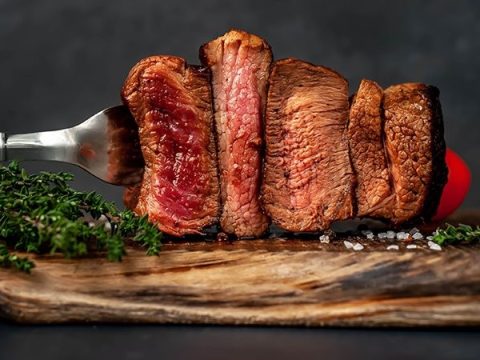How to Choose and Cook the Perfect Beef Steak
A great beef steak is a special occasion in itself — a beautifully marbled, pink, tender cut of premium meat, cooked just right. It’s not an everyday dish, partly due to the higher price, but with the right selection and technique, you can enjoy a steakhouse-quality experience at home.
Beef Breeds Known for High-Quality Meat
The first challenge is selecting the right beef. Some cattle breeds are famous for their tender, flavorful meat and are staples in top steakhouses around the world. Here are some of the most renowned:
- Angus – the most common and accessible in supermarkets
- Hereford
- Charolais
- Limousin
- Wagyu
- Texas Longhorn
- Chianina
The Best Cuts of Beef for Steak
Not every part of the cow is suitable for steak. Cuts like shank, brisket, or round are better for stews or braises. For steak, professionals recommend cuts from three main areas: ribeye, tenderloin, and striploin.
✔️ Pro Tip: Don’t Fear the Fat!
Marbling — the white streaks of intramuscular fat — is key to a tender, juicy, flavorful steak. As the steak cooks, this fat melts and enhances texture and taste.
1. Ribeye
- Cut from the rib section
- Rich in fat and flavor
- Very tender and juicy
- Often found with the bone as “Tomahawk steak”
- Best cooked on grill, cast iron, or under a broiler
2. Tenderloin
- Exceptionally soft and buttery texture
- Low-fat content but still rich in flavor
- Filet mignon is cut from the smaller end
- Used in dishes like Beef Wellington
- Ideal for pan-searing or grilling
3. Striploin (New York Strip)
- Neighbor to the ribeye
- Rectangular shape with good marbling
- Intense flavor, firmer texture than ribeye
- Common in steak sandwiches
4. T-Bone / Porterhouse
- Combination of tenderloin and striploin
- Separated by a T-shaped bone
- Offers the best of both worlds
- Requires attention while cooking due to different cook times on each side
How to Cook Steak to Your Preference
Once you understand the differences between cuts, cooking becomes easier. However, if you’re new to steak, it’s best to practice before cooking for guests — especially those who know exactly how they like their steak cooked.
Levels of Doneness (Use a Meat Thermometer!)
Rare (50–55°C / 122–131°F)
Red center, barely cooked. Soft, juicy, and vivid red. Only recommended with very high-quality meat.
Medium Rare (55–60°C / 131–140°F)
The most popular level among chefs. Warm red center, slightly firm, seared outside with defined grill marks.
Medium (60–65°C / 140–149°F)
A safe choice for beginners. Slightly pink center, more firm, less juice than medium rare.
Medium Well (67–74°C / 153–165°F)
Minimal pink left. More cooked, firmer texture, and some loss of flavor and nutrients.
Well Done (77°C+ / 170°F+)
Fully cooked through, uniformly brown. Dry and firm. Least tender and least flavorful.
General Cooking Tips
- Use a cast iron skillet or grill pan heated very well before searing.
- Avoid piercing the meat multiple times to retain juices.
- Let the steak rest for 5–10 minutes after cooking to allow juices to redistribute.
With the right cut, proper marbling, accurate timing, and a good pan or grill, you can prepare a steak that rivals the best restaurants. Practice makes perfect — and delicious.


